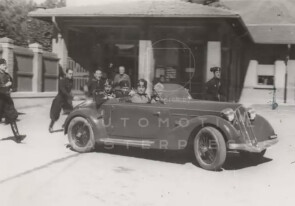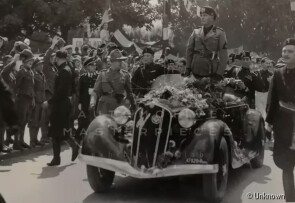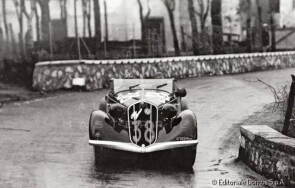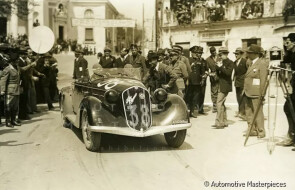
1935 Alfa Romeo 6C 2300 Gran Turismo "Pescara" Spider
ON/OFF
Why am I an Automotive Masterpiece?
D. Remaining cars from extremely limited production runs
1 of 2 manufactured
G. Team cars
Scuderia Parioli Roma (I)
K. Famous chassis’ cars
The last chassis of 6C 2300 Pescara built (chassis range from 700.101 to 700.635).
L. Limited edition cars
no. 2 manufactured. 1 of 2 manufactured
The history of Alfa Romeo coincides basically with the history of the automobile and features many stories and numerous cars. The Alfa Romeo 6C stands out amongst the most representative models – the cars of the beginning and the modern post-war ones, and the racing and touring cars. The long journey of the Alfa Romeo 6C lasted almost 25 years, accompanying Alfa Romeo industries from the 20s to the 50s. In the early 1920s, Vittorio Jano was commissioned with creating a lightweight, high-performance vehicle to replace the large and heavy RL and RM models. Between 1927 and 1954, the Alfa Romeo 6C was produced in a series of models: road, race, and sports cars. The "6C" name refers to the number of cylinders of the car's straight six-cylinder engine. The different models’ bodyworks were made by coachbuilders such as Castagna, James Young, Pinin Farina, Touring and Zagato. From 1933, a custom-made Alfa Romeo’s built bodywork became available; it was made in Portello. The car was introduced in April 1925 at the Salone dell'Automobile di Milano as the 6C 1500. The 2-litre formula - that led Alfa Romeo to win the Automobile World Championship in 1925 - changed into the 1.5-litre formula for 1926’s races season. The production started in 1927, with the P2 Grand Prix car as a base model. The more performative 6C 1750 was introduced in 1929 in Rome. The car featured a top speed of 95 mph (153 km/h), a chassis designed to flex and bend over curved surfaces, as well as sensitive geared-up steering. It was produced in six series between 1929 and 1933. The base model had a single overhead camshaft. The Super Sport and Gran Sport versions had a double overhead camshaft (DOHC), and a compressor was available. Most of the cars were sold just as a chassis then bodied by coachbuilders. The 1750 quickly gained a reputation for winning races. In 1933, the last year of the 1750 production, the new Alfa Romeo 6C 1900 version was introduced, with a displacement of 1917 cm³ and with a light alloy head – used here for the first time. To satisfy the market’s request for a high-performance automobile sold at a lower price, Alfa Romeo introduced a new car at the Salone dell’Auto di Milano in 1934: the 6C 2300. The car was designed to replace the 6C 1750 and its derivate, the 6C 1900. Despite the many successes, the 8C 2300s remained designated for races and never appeared in the sales catalogues. The 6C 2300 debuted at the 1934 Giro Automobilistico d’Italia. However, only at the 24 Ore di Pescara, three Gran Turismo cars with bodyworks by Carrozzeria Touring won the first three places. Therefore, after the race, Alfa Romeo began to sell the model under the new name “Pescara”. The 6C 2300 was available as Turismo and Gran Turismo. The Gran Turismo version had better performances and also the reduction of the wheelbase (2920 mm). Except for the reduction in length, the chassis was identical to that of the Turismo model and was not distinguished by any particular technical innovations. Production was limited to 1934, and the chassis of all Gran Turismo versions were numbered from 700101 to 700635. A total of 1.606 specimens of 6C 2300 were produced, including bare chassis for the coachbuilders and complete cars. Alfa Romeo cars were absolute leaders in the history of the Mille Miglia race, and the various 6C models participated with actual squadrons, led by the most talented drivers of the time. The 6C 2300 participated in the Mille Miglia in four different years. Its debut was in 1935 when a specimen led by Franco Cortese earned the 8th place overall. At the 1936 Mille Miglia, three out of four participating 6C 2300s ranked 9th, 11th and 13th overall. Ercole Boratto, Mussolini's driver, drove the last one. The 6C 2300 were also the only ones registered, in that year, in the "Classe oltre 2.000 cc senza compressore" and, therefore, they were 1st, 2nd, 3rd in their class. In 1937, the 6C 2300 ran the Mille Miglia with 10 cars in their various versions. Ercole Boratto earned the best result in arriving 4th overall. In 1938, the 6C 2300 ran the Mille Miglia with 12 cars in their various versions. Franco Cortese earned the best result in arriving 9th overall.
The 1935 Alfa Romeo 6C 2300, chassis no. 700635 is a Pescara Spider model by Carrozzeria Touring and is from the first series of 6C 2300, retrospectively called 6C 2300 A. “Sports cars and tyrants don’t usually go together, but Fascist president Mussolini had different ideas.” Said Mick Walsh, on Classic & Sportscar, March 2008. This Alfa Romeo 6C 2300 Sport Spyder is one of two built and was destined for the most important man in pre-war Italy: ‘Il Duce’, Cavaliere Benito Mussolini, as recorded in long hand on the car’s original registration documents. Mussolini was a keen driver and a faithful supporter of Alfa Romeo, who once described it as a "national jewel," even decreeing that it receive much needed government funding during the early 1930s economic. The fascist dictator’s chauffeur and confidante, Ercole Boratto, was an ex-Alfa Romeo test driver, who said that Mussolini "adored machines, especially motor cars and parading about in them. He loved to be recognized by the people and to be noticed principally by the female sex…" 6C 2300 7th series was powered by an engine available in three states of tune, the most powerful of which developed 95 hp at 4,500 rpm. Mussolini’s 6C 2300 received an engine tuned to this specification developed by Scuderia Ferrari during the 1934 competition season and Touring’s body design was altered extensively immediately after delivery until it was exactly to Il Duce’s liking. The bodywork fitted to chassis 700635 did not have an easy genesis. The first version was delivered to Mussolini in Rome by the official Alfa test driver Giovanbattista Guidotti, accompanied by the photographer Fumagalli. The Spyder was initially rejected by Mussolini; the Duce was struck by the beauty of the car, but pointed out the absence of the rumble seat. Rarely without his chauffeur, ll Duce perhaps felt the need to accommodate any "target women" he might encounter. He also complained the interior in natural leather, an unwelcome color: "I'll keep it for a week - he told Guidotti - but please inform Touring to immediately think about these changes which are of vital importance to me". The structural changes were carried out in just ten days, as the head tinsmith of the Milanese atelier, Beniamino Colli, would later have said. The bonnet was altered so that cooling vents ran horizontally rather than vertically, giving the impression of greater length. The interior was upholstered in dark leather. “La bella figura” is the uniquely Italian requirement to present the best face to the world. It's no surprise that Mussolini, who carefully chose his tailored uniforms, suits, and hats, was equally attentive in the style of his cars. “Throughout the summer of 1935 the Spyder, often festooned with flowers, was used as the parade car for propaganda tours, including on the Ligurian Riviera. Mussolini would stand boldly on the passenger side with little apparent concern about attempts on his life” added Mick Walsh. The same scenes were seen during the military "great maneuvers" in Trentino - Alto Adige (at the time "Venezia Tridentina"), including numerous parades, and was immortalized on its journey up to the border of Bressanone and then to the Gulf of Trieste to bring the dictator to the naval review with the king Vittorio Emanuele III. The following year, Mussolini entered the 6C 2300 in the Mille Miglia under the aegis of Scuderia Parioli, founded by his son Vittorio Mussolini, for his chauffeur Ercole Boratto; the only open 6C 2300 of a quartet entered but, in the light of sanctions imposed on Italy following its invasion of Abyssinia, he ordered the car to be converted to run on alcohol in the ‘alternative fuels’ class. Alfa Romeo’s long serving test driver Giovanbattista Guidotti, who was tasked with preparing Il Duce’s Alfa for its Mille Miglia entry, recalled many years later: “A second tank for the alcohol was fitted in place of the dickey seat, but there was a hidden lever beneath the dashboard allowing us to run the car on normal fuel after we had passed the checkpoints. The car did actually manage to use a few drops of alcohol. Anyway, the publicity value was worthwhile…” In the event, Boratto and co-driver Mancinelli ran a flawless race to place 13th overall and 3rd in the over 2-liter unsupercharged class and their performance is immortalised in an Istituto Luce film. The images of the car in the race show another detail: the windscreen glass was cut down for a sportier use/look. Il Duce kept his personal Alfa Romeo until November 1939; bought back by Alfa Romeo (filiale di Roma), chassis 700635 then passed to a lesser party official who painted it army green, hostilities having now opened. He hid it later in the war, afraid that it may be recognized, but the car remained in his ownership until the 1960s when, after his death, it was inherited by a relative in a sorry state. Eventually in 1972 pioneering motoring historian, collector and plastic surgeon Dr. Luigi Fittipaldi (of the same family of the famous Driver) was able to acquire the car. Fittipaldi, author of the book "Tutte le ‘Alfa’ di Mussolini", has also reconstructed the story of this car. With an acute sense of history, he has restored the car with extreme sympathy. It remained in his ownership until, exactly 50 years after the end of WW2, it was sold at auction in May 1995 by Simon Kidston to Giuseppe Calgaro, an Italian sports car collector. Calgaro ran the car in the Mille Miglia retrospective before selling it to restorer/dealer Ugo Isgro of Treviso, near Venice. He embarked upon a complete rebuild which was carried out by Dino Cognolato, Italy’s best-known restorer, and finished in time for the car to be shown at Pebble Beach in 2005 where it received a 2nd place in class. In 2012 earned another 2nd Place at the Villa d’Este Concours. From 2012 to 2016 the car has participated at the Mille Miglia. In 2018 it was completely checked including the meccanic by the famous Quality Cars in Vigonza (Padova – Italy). In the same year Mille Miglia it was driven by Gianfranco Fisichella, ex F1 Ferrari racing driver. The following year it participated with Emanuele Pirro, 5 times winner of Le Mans, at the wheel. The car, still matching numbers, was often featured in the main and specialized press. Despite the car having already been restored to the highest standards, it underwent an additional, long, and meticulous restoration, in full respect of its original features. The low windshield, as adopted for participation in the Mille Miglia, was deliberately preserved. Furthermore, recognizing the car's value as a work of art, it was possible to use, during the restoration painting process, a special nitro paint, recreated in small quantities for such cases, which faithfully reproduces the finish, tone, texture, and reflections of the original paint, along with Connolly leather interiors matching the original, in dark red. As far as is known, this car is the only first-generation 6C 2300 Pescara to have been bodied as a Spyder by Touring. A dedicated Monographic Chassis Book on the car will be published by Automotive Masterpieces. Its researches are RINA certified.






